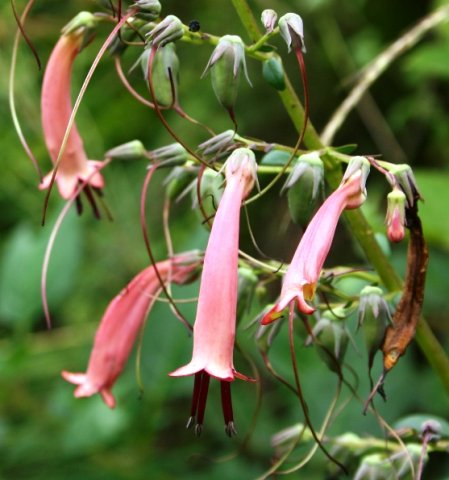Phygelius aequalis

Author: Ivan Lätti
Photographer: Johan Wentzel
Phygelius aequalis, commonly known as river bells and in Afrikaans as rivierklokkie (river bell), is a fast-growing, evergreen shrub reaching heights from 1 m to 2 m. The shrub is somewhat herbaceous, its stems woody low down. The stem-shape is four-angled, square in cross-section.
The simple, leaves are opposite, their petioles (stalks) about 2 cm long. The leaf-shape is oval to elliptic with acutely pointed tips and toothed margins. The blades are dark green and soft.
The curved, pale pink corolla tubes widen to their mouths where the five short, pointed lobes spread. The narrowly pointed sepal lobes at the back are small, veering away from the tubes more or less, while always ascending. The four stamens have thick, dark filaments that protrude from the corollas and tiny anthers, here partly whitish. The superior, ovoid ovaries are green, tipped with long, curving styles that persist longer than corollas or stamens and backed by the durable calyces.
The species distribution is in the far north of the Eastern Cape, the far east of the Free State, the west of KwaZulu-Natal, Mpumalanga and Limpopo. It also grows beyond the border in at least Lesotho and eSwatini.
The habitat is high altitude streambanks in the Drakensberg, rocky woodland and bushy valleys. The name Phygelius may be derived from the Greek words phyge meaning flight and helios meaning sun, probably referring to the plant's avoidance of full sunlight, a shade lover often growing under trees. The habitat population is deemed of least concern early in the twenty first century.
The plant has earned its place as a garden subject from the long blooming season of pendulous trumpet flowers in great profusion. Robust growth and cold resistance contribute. The yellow flowering form is also popular, while there is a purplish pink variety besides the common salmon-pink one. Several garden cultivars have been produced from the two species, P. aequalis and P. capensis, both South African, as well as from their natural hybrids. The plant is grown from seed or cuttings (Manning, 2009; Pooley, 1998; iNaturalist; https://pza.sanbi.org; http://redlist.sanbi.org).

